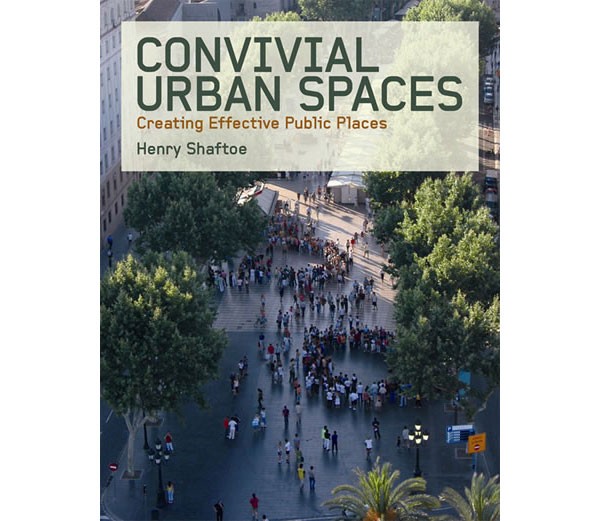Author: Henry Shaftoe (EarthScan, 2008)
Henry Shaftoe’s Convivial Urban Spaces: Creating Affective Public Places is a thorough and informative investigation into what is needed to make public spaces convivial, which he defines as: “Places where people can be sociable and festive…” He addresses dauntingly broad topics by breaking them down into smaller ideas and using real-life examples, including five detailed studies from Barcelona, Berlin, Bristol, Padua and York, to present a set of instructions which may facilitate the creation of healthy and inviting urban spaces.
Shaftoe opens by addressing public spaces in a larger context: why do we need public space and who are they for? He remarks on the importance of usable public space as a gathering place for democratic systems, a learning place where various demographics can meet and interact, a natural space, and a place of “urban security.” Shaftoe also investigates exclusive and inclusive spaces and the unsuccessful tactics used to control the public realm such as the London CCTV system, physical and legal barriers, and over-policing.
The second half of the book is dedicated to looking more closely at what makes a space convivial, how to make it so, and most importantly, how to maintain it as such. Here Shaftoe discusses the psychology of public spaces and what might affect our senses in a public place – such as noise from a water fountain or smells from food venders or plant life. He discusses shapes and types of space, and how different characteristics such as colour, art, and hard or soft landscaping in a public space can evoke emotions such as joy.
Shaftoe implies that the space between the buildings is more important than the buildings themselves, and that patrons of all ages, sizes, genders, ethnicities or social-economic background, should be welcome into any public space. He talks of about a bottom-up versus top-down system of design, and he references urban design theories such as Christopher Alexander’s notion of “growing” spaces rather than “building” spaces. Shaftoe also remarks quite candidly on the need for kids and young adults to “get into trouble,” pointing out the natural tendency for kids to hang around public spaces, get in fights, and experiment: “we can’t stop kids from indulging in drugs, sex and rock’n’roll; indeed the more we try to ban these things the more attractive they appear…” He suggests that rather than trying to prevent it, public spaces should provide safe, welcoming, and secure zones in which kids can be kids.
Shaftoe states that a key ingredient in designing convivial spaces is adaptability, and a change in legislation that allows for more long-term interests on behalf of the designers and planners. He says: “very few architects and planners revisit the developments they helped to form to see how they’ve fared over the years.” Which means there is no incentive to return to a space that may need design changes, and it makes it very hard for designers to learn from past successes or mistakes. Although Shaftoe notes that there is no all-encompassing solution for creating convivial spaces, he does highlight the common elements that most convivial spaces seem to share, categorizing them as: physical, geographical, managerial, physiological and sensual. He includes a comprehensive list of Do’s and Don’ts including points such as: “Do: Think about micro climate and provide protection and shelter as appropriate… Don’t: put too many restrictions on the use of public space.” He also addresses materiality issues: “Do: use the highest quality materials, fittings and plants the budget can afford (this will save them money in the long run… Don’t: use single-leaf brickwork or blockwork for walls as the will eventually get pulled down.”
This impressively concise book packs a wealth of information for architects, urban designers, and community members alike. It is enjoyable and comprehensive, and it offers valuable suggestions on how to understand public space and how to design vibrant and convivial public spaces. Shatfoe’s analysis of the conviviality of the public realm is thoughtful, logical and detailed. He is meticulous in his case studies, his collection of data, and his choice of references. His points are straightforward and easy-to-apply to spaces in cities around the world, and, most importantly, are critical to the creation of positive healthy spaces.
***
For more information on the book, visit the Convivial Spaces website.
**
Ellen Ziegler has a Masters in Advanced Studies of Architecture. She lives in Toronto and spends most of her time biking, exploring the city, drinking coffee, and writing book reviews.





2 comments
http://www.torontopubliclibrary.ca/detail.jsp?Entt=RDM2446350&R=2446350
Have a look at this book at the Toronto Reference Library, 789 Yonge Street, second floor, Humanities and Social Sciences Department:
Call number: 711.4 S334
http://www.torontopubliclibrary.ca/detail.jsp?Entt=RDM2446350&R=2446350